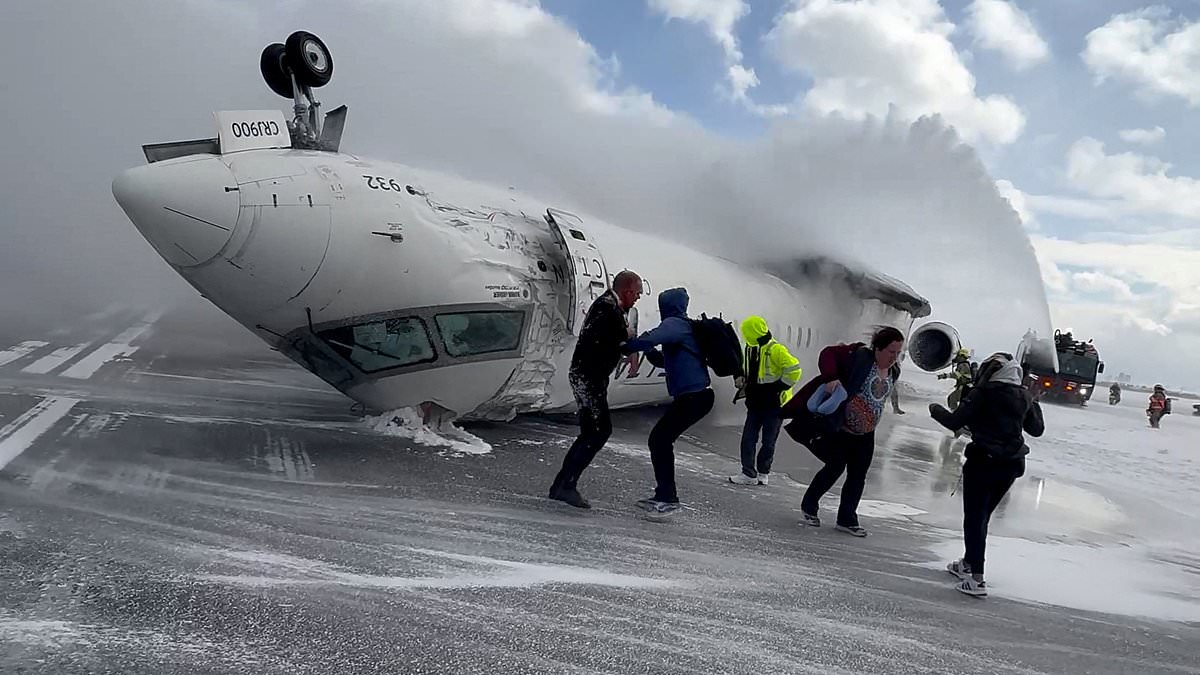Copyright dailymail

Air traffic control shortages have left America's skies so fraught with danger that horrific plane crashes seem all-but-inevitable, experts have warned the Daily Mail. An early sign of trouble came in the form of recent ground stop notices at Newark Liberty International Airport in New Jersey, Boston Logan Airport, Los Angeles International Airport and both Fort Worth and Love Field airports in Dallas. And on Wednesday evening, Newark issued a six-and-a-half-hour ground stop that halts flights at their origin from taking off to the New Jersey travel hub, with delays for those hoping to leave the NYC-adjacent hub of up to 87 minutes. Now, experts warn that the ongoing government shutdown risks triggering a safety spiral, as already short-staffed air traffic controllers call out sick after five weeks without a paycheck. And those who are hanging on are more stretched than ever. 'The shutdown increases both fatigue and stress - therefore, the likelihood of human error increases,' Randy Klatt of the Foundation for Aviation Safety told the Daily Mail. 'Near misses become more likely, as do disasters.' As many employees take on second jobs and deal with the pressures of not being paid, staffing levels at some air traffic control towers have dropped to 50 percent of what they should be, according to Transportation Secretary Sean Duffy. 'My job is to keep the airspace safe. And so, if I don't feel like I have enough controllers or enough controllers that are focused, we will slow down traffic, we will stop traffic,' Duffy said in a press conference earlier this week. Pleading with congress to end the shutdown, National Air Traffic Controllers Association (NATCA) President Nick Daniels called the lack of pay a dangerous distraction to staff. 'Every day that this shutdown drags on, the system becomes less safe,' he warned during a press conference. Fully-qualified air traffic controllers starting salaries range from $60,000 to $130,000, according to FlyingMag. Salaries max out at around $175,000, but air traffic controllers can earn more by doing overtime. Jack Criss, an air traffic controller who has had to work DoorDash delivery shifts on top of his job to get by, has described the strain the shutdown has placed on him and his colleagues. 'It is hard enough just going to work,' Criss told CBS. 'Now, when you add not getting paid, that's when you just like multiply the level of pressure. And you know, air traffic is a safety sensitive position. The margin of error is zero.' Speaking to the New York Post earlier this month, another air traffic controller said: 'The financial anxiety doesn't just hurt morale; it directly affects safety. 'When someone responsible for thousands of lives a day is worrying about whether they can pay rent or feed their kids, focus suffers. Sometimes that small moment where your mind is elsewhere can have serious impacts.' More than 14,000 controllers employed by the Federal Aviation Administration (FAA) will not be paid until the shutdown ends, and the uncertainty of when that will be is weighing on many. 'This certainly is a concern and is absolutely not ideal to have these kinds of stresses and worries while staff are being asked to show up for work,' Dr Hassan Shahidi, the President and CEO of the Flight Safety Foundation, told the Daily Mail. 'As this drags on and we get to the next paycheck not being paid, that is going to be heavily affecting these controllers.' Despite the challenges they're facing, the majority of air traffic controllers across the country have vowed to continue working to ensure Americans fly safely. 'They are professionals, they are dedicated, and when they're on the job, they'll be doing their best in terms of performing that function and keeping keeping air traffic safe,' Shahidi said. But a fraction of workers are calling in sick, the transport secretary warned last week, claiming some 'problem children' are 'lashing out' at not being paid, causing further disruption. The FAA has been closely monitoring staffing levels across the country. It slows down or even stops air traffic where there is not enough coverage. Shahidi explained that in the event that staff levels are critically low, as was the case at Hollywood Burbank Airport earlier this month when its tower stood empty for hours, flights are delayed or larger facilities take on air traffic control responsibilities. But, he said, such a situation is 'very difficult to manage.' While smaller airports are more affected by staff shortages, Shahidi added, things will get worse for major airports, too. 'The large hubs in the US - Chicago, New York, Los Angeles, Miami - are of course very important to the whole heartbeat of the entire aviation system. If any of these hubs have limited capacity, it will impact the whole country. 'It's a cascading effect, and that is going to be the inflection point that will really cause major disruption.' This appears to be happening already. On Sunday morning, flights departing for Los Angeles International were halted due to a staffing shortage at a Southern California air traffic facility. On the same day, staffing shortages also caused takeoff and arrival disruptions at Newark and Teterboro Airport (also in New Jersey) and at Southwest Florida International Airport in Fort Meyers, according to the FAA. In recent days, thousands of flights across the US have been snarled, with nearly 7,000 flights delayed on Monday and 8,800 on Sunday. According to Duffy, 44 percent of delays on Sunday and 24 percent on Monday were caused by air traffic controller absences, compared to 5 percent on average before the shutdown. With the worsening situation for air traffic controllers coinciding with Thanksgiving and the busiest travel period of the year, Shahidi told the Daily Mail he believes things are now coming to a head. 'As we approach November, I would really hope that the administration and Congress can come to an agreement to lift a shutdown and get back to normal operations,' he said. Terrifying past incidents serve as a warning for what could happen if controllers lose focus or stop showing up. In August 2023, a Southwest Airlines passenger plane and private jet came within 100ft of each other on the runway at San Diego International Airport, a recent safety report stated. The National Transportation Safety Board (NTSB) found that both the controller managing the aircraft and their supervisor made 'bad choices' that diverted their attention from the landing procedure. Disaster was only averted when the airport's automated tracking system warned the controller and the private jet quickly circled before landing without incident. Across the US in 2024, there were 1,474 recorded runway incursions - incidents 'involving the incorrect presence of an aircraft, vehicle or person' on a runway - and 2023 had a total of 1,777, an average of five per day. While plane crashes are exceptionally rare, high-profile incidents this year have shaken consumer confidence and highlighted the importance of aviation safety. In January, a US Army Black Hawk helicopter smashed into an American Airlines jet over the Potomac river, killing 67 people. It was the deadliest US airline crash in more than two decades. Then, in February, a Delta plane crash-landed and flipped over at Toronto's Pearson International Airport. All 80 people on board survived. Neither of the crashes are believed to have been caused by air traffic control error and both are still being investigated. Nevertheless, Klatt, a US Navy veteran, warns similar horrors could soon be on the horizon if air traffic control shortages continue. In the four years before the Washington crash, the NTSB highlighted that there had been 15,214 'close proximity events' between commercial airplanes and helicopters at Ronald Reagan Washington National Airport. Most of these involved a lateral separation of less than one nautical mile and a vertical separation of less than 400ft, the NTSB said. But 85 had lateral separation of less than 1,500ft and vertical separation of under 200ft. 'The FAA failed to act on any of those incidents and the tragic mid-air collision of January 29 occurred,' Klatt told the Daily Mail. 'Those types of incidents will no doubt increase with the shutdown. We can only hope there are no serious accidents.' Even before the shutdown, ground staff and pilots raised concerns about stressors on the system, with many pointing to lack of air traffic control staff as a major concern. According to the NATCA, the number of fully certified air traffic controllers is currently at a 30-year low. Klatt is among those who blame the FAA, saying it has failed to properly staff air traffic control towers 'for decades.' 'Despite efforts to improve the situation, we are still significantly short of qualified ATCs,' he told the Daily Mail, pointing to problems like the lengthy training process, the military turning out fewer certified controllers, the mandatory retirement age of 56, and a maximum application age of 30. 'It's a real mess that will take time to rectify.' 'Prior to the shutdown, there were already concerns,' Shahidi also said. 'There are traffic controllers that are working six days a week, 10 hours a day on a regular basis.' On top of that, efforts to modernize the system - which he described as 'absolutely necessary to ensure an efficient, safer air traffic control system' - have also been halted by the government paralysis. 'We have an infrastructure that has been struggling in terms of the communications and navigation systems, and we've seen examples of that in different facilities around the country, affecting the efficiency and ability of those airports,' Shahidi said. While aircraft inspections are continuing, the shutdown also means that the FAA has stopped issuing Airworthiness Directives, which mandate safety fixes to existing aircraft, according to the NATCA. The association said this is causing delays in maintenance and the updating of safety protocols, which is therefore putting crucial aviation technology at risk of falling behind or malfunctioning. The shutdown is also impacting the training of future aviation safety workers, Dave Spero, president of the Professional Aviation Safety Specialists, said in a press release. The release said employees being trained at the FAA Academy in Oklahoma were forced to abandon their training and go home on October 3 as there was no funding available to keep them in their classes. Spero warns this will impact staffing levels in the future, adding that fully training a technician can take three to five years. 'Any lapse in training can push the clock back, as it did during the academy's closure during the pandemic,' he said. 'For every day the government is shut down and employees in the aviation ecosystem are still furloughed, another layer of safety may be peeled away.



